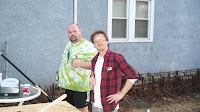So we are are hitting that magical ear
mark of the growing season, the 4th of July. I have been
getting a lot of questions about fertilizer. When, what, how and
why. Let's start at the starting point, the point when you have
pulled all your plants in the fall. You will remove a bunch of the
leftover foliage and this is a great time to do some green
composting. Green composting you ask? Green composting is planting
ground cover that is high in nitrogen and can be tilled under to
provide great growing medium the following year. Some people choose
to plant ground cover in between rows or in the furrows through out
the year, I like to do it in the fall allowing the ground cover to
die off before seeding. Another option is in the fall after you
have pulled you carrots and the brussels sprouts have seen their
first frost, you can add compost from your compost pile or bring it
in from a commercial outfit. Either way bringing in composted
materials in the fall is a great way to get ready for the following
season.
Now lets talk about spring. You can add compost or my
favorite, composted manure to the garden tilling. By adding
composted materials you are ensuring that your plants will have the
nutrients that they need to grow up big and strong. Plant location
is another important thing to look at. Some plants like tomatoes and
corn use up a lot of the soil's nitrogen. While others like beans
and peas tend to enrich the soil with nitrogen producing bacteria.
So plant the tomatoes where the beans were last year and plant the
beans where the tomatoes were. Hows your sun? Without the required
amount of sun all the fertilizer in the world wont do you any good.
So be sure to plant the plants that need the most sun in the sunniest
spots.
Okay so its the beginning of the growing season, you have all
the plants in the ground when should I use that miracle growth stuff?
Never! Plants do great with organically produced nutrients, you don't
need any witch's brew. I like to use fish emulsion and composted
chicken poop (be sure you read the directions on this one). I use the
chicken poop before it rains about a month after my garden has been
planted and then once a month after that. On a quick note, I have
found that our dog Roscoe really enjoys the chicken poop too, so if
you have a dog be sure its not stealing food out of your plants
mouth. I use fish emulsion after I have watered, about every 7-10
days. I find that it is really hard to burn your plants with the fish
emulsion, the chicken poop on the other hand can be very easy to burn
the plants. I use all these fertilizers according to the directions
on the package. It may take a little experimenting before you find
the right combination, but that's part of the fun. One final note,
record keeping can be very helpful in determining you what's working
and what's not.
Happy Growing














